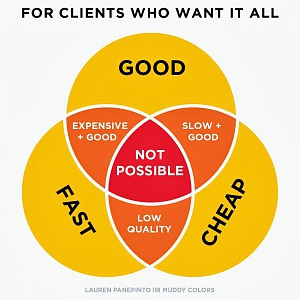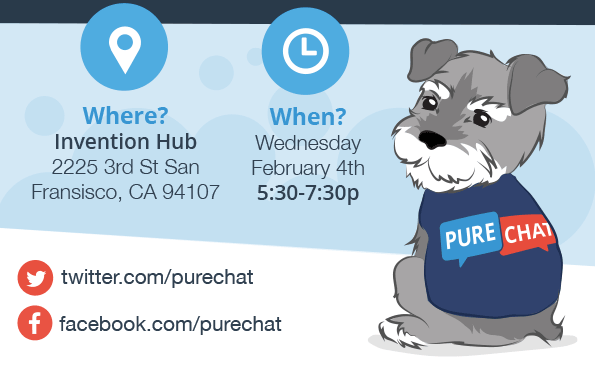 There’s a running joke that exists among agency types and creatives: fast, cheap, good—pick two. To elaborate, clients can have something fast and cheap, but it won’t be good. They can have something good and cheap, but it won’t be fast. Or they can have something fast and good, but it won’t be cheap. But what about fast, cheap, and good? And therein lies the joke: these folks will say that trifecta is impossible—a unicorn. Keep dreaming, they say.
There’s a running joke that exists among agency types and creatives: fast, cheap, good—pick two. To elaborate, clients can have something fast and cheap, but it won’t be good. They can have something good and cheap, but it won’t be fast. Or they can have something fast and good, but it won’t be cheap. But what about fast, cheap, and good? And therein lies the joke: these folks will say that trifecta is impossible—a unicorn. Keep dreaming, they say.
But you’re not an agency type or a creative. You’re a small business. And as history has shown, when it comes to business, unicorns are possible, and dreaming is a key component of innovation. Thus, from the perspective of small businesses, good, fast, and cheap might very well be possible—if you play your cards right.
Take content—like blog posts, white papers, videos, webinars, etc.—for example. Google loves high-quality, relevant content, and the more of it your website has, the better. But generating content isn’t everyone’s forte, and it takes time. So how do you—as a small business—achieve good, fast, and cheap content generation?
For a small businesses, good, fast, and cheap content might be possible—if you play your cards right. Click To Tweet
Getting It Cheap
There are agencies out there for everyone, including small businesses. But if you’re super strapped for cash, tasking content creation to an agency might cost you more than you’re able to pay. That’s when you look inward. You and your team—and possibly your family and close friends—know more about your product and audience than anyone else. Use that to your advantage; use it to fuel your content efforts.
Also, make sure you’re amplifying your content. The whole point of content creation is to drive traffic to your website. That means you need to point people in the right direction. Thus, whenever you publish content, make sure you’re pushing it to all your channels, such as social media, email newsletters, and syndication sites.
Another way to get more bang for your content buck is to repurpose it. That also saves time, though, so I’ll cover it below under “Doing It Fast.”
Making It Good
Not everyone’s a writer. Unfortunately, that’s what stops so many people from creating content. They get bogged down in labels. Here’s the thing, though: You don’t have to be a good writer to create quality content. That’s because great content is ultimately about helping your audience.
The Road to Good Content
- Get together with your knowledgeable crew and brainstorm: What are the problems facing your audience? Think narrow and broad, and don’t restrict your answers to merely problems your product solves.
- Need help brainstorming? Tap your audience. Check message boards, comment threads, social media pages, or your website’s live chat tool to learn what problems your audience is facing and what questions they’re asking.
- Take all those problems and organize them into categories or themes. These will serve as the rubric for your content calendar, which helps boost SEO.
- Examine your business roadmap. What events, launches, or campaigns do you have on your calendar? Do you have a content category or theme that aligns well with any of these efforts? If so, make them concurrent. That way, the two work in tandem. If not, then I recommend setting a theme per quarter.
- Return to your list of audience problems. Structure all of these conundrums as questions. Each answer to a question—each solution to a problem—becomes a blog post, all of which you organize within your categories or themes.
The Act of Creation
You have your questions. Now answer them. Remember, you’re the expert; you’re here to help your audience. Who cares about your actual writing? You’re simply focusing on answering their question. Once you’ve written your answer, structure it into a blog post:
- Introduce the problem or question; provide some context; and explain how you’re going to solve it.
- Explain your answer or solution; make sure you account for any sub-questions, and answer those, too.
- Give an example if it’ll help clarify your point.
- Summarize. If someone skipped your entire article and jumped right to the end, what would you want him or her to know? Give it to them in a few sentences or bullet points.
- Offer next steps. Okay, so you answered their question. What’s next? Can you direct them to more content on your site, additional resources elsewhere, or—even better—your product or service?
- Come up with your title or headline. Often times, this is simply the question your post is answering. Unlike Jeopardy, though, you don’t have to always phrase your headline in the form of a question. You could take the approach of a how-to or list. For example, “how do I know if my refrigerator is efficient?” could become “5 Signs Your Fridge is Wasting Electricity” or “How to Make Your Refrigerator More Efficient.”
The Path to Polishing
Once you have your blog post, there are several things you can do to make it publish-ready:
- Step away from the post for a few hours, and then return to it for a re-read. Even better: re-read your post aloud. You’ll catch a lot of wonky sentences that way.
- Examine your content to ensure it’s easy on the eyes. Are there places where you could add sub-heads or turn things into lists? Can you break up any long paragraphs into multiple, shorter paragraphs?
- Share it with a trusted friend, teammate, or editor. Whether it’s your child who happens to be an A-plus student or your administrative assistant who has an eye for detail, share your blog post and ask for a review. This person should feel comfortable suggesting edits, correcting errors, and asking for clarification where needed.
Doing It Fast
You created your content calendar, and you’ve started writing blog posts. Now how do you do all of this more efficiently and at scale?
Simplify and Stay Specific
There’s a saying about shoving ten pounds of, well, stuff into a five-pound bag. Unless you’re answering the simplest of questions and you have several that relate (in that case, create an FAQ), you should stick to answering one question per blog post. And that one question should be as specific as possible. The broader the question, the more multi-faceted it is, and that means it’ll take you a lot more time and paragraphs to answer it. So:
- make your questions super specific,
- keep your answers focused,
- use bulleted lists where possible, and
- if you discover you’re shoving more than “five pounds” into your blog post, turn it into multiple posts.
Focus
Many people pridefully boast that they’re exceptional multitaskers, but when it comes to content creation, it’s nothing to brag about. That’s because multitasking is an epic timesuck. When you try to do multiple things at once, you’re forced to constantly switch gears, and every time you do, you must allow your brain time to refocus. All that refocusing time adds up.
People say they’re great multitaskers, but in the #content creation game that's nothing to brag about. Click To TweetDo not multitask when you write. Sit down, and write—no tab switching, no phone scrolling, no breaks. Write until you’re done. I recommend doing this at whatever time you feel most alert and creative. For me—and the content geniuses at Buffer—that’s in the mornings.
Curate
Writer’s block happens to all of us. Don’t beat yourself up over it. Some days the content doesn’t flow. Other days, the words may runneth over, but you’re super strapped for time. That’s where curation comes into play. Content curation is the act of amassing other’s content and organizing it in a way that benefits your audience. Here are some examples:
- Search YouTube for a video that answers or helps answer your blog post’s question. Embed that video in your post, and then write a response, reaction, or summary of the video. If the video only helps answer the question, expand upon the video to round out the post.
- Interview customers or experts relevant to your industry, and share that Q&A as a blog post.
- Find a bunch of articles that all relate to a common theme, and organize them into a list.
Check out this Digital Marketer post for more curation examples. One crucial thing to remember with curating content: Always give credit where credit’s due. In other words, cite your sources by providing a link to the original work.
Repurpose
As a small business, you know better than most that time is not only finite, but so very precious. Repurposing helps you maximize time. It gives you more bang for your content buck; it gives your content longer legs. Okay, enough with the cliches. To put it simply, repurposing is using content you already have to generate more content. So, once you’ve amassed some blog content, you repurpose it.
Repurposing helps you maximize time. It gives you more bang for your content buck. Click To TweetWhich blog posts do I repurpose?
- Choose blog posts with topics that are timeless and high quality. In other word, choose content that’s evergreen.
- Check your analytics to find your most popular blog posts.
- Examine your content calendar to determine which topics you’ve covered in the past that you could easily expand upon. Do you have more to say now than you might’ve in the past?
How do I repurpose?
- Rework content into a new post. How can you say the same thing in a new way or from a new angle? Or how can you expand upon what you’ve already said? Alternatively, how can you cover the topic from a more narrow aspect?
- Turn your post into a how-to guide, ebook, or white paper.
- Use the post as the basis for a customer case study.
- Convert the post into a presentation, webinar, or SlideShare.
- Enlist a graphic designer (or use tools like Infogram, Picktochart, or Visual.ly) to turn your post into a visual, like an infographic or instructographic—two things Pinterest loves.
Want additional repurposing ideas? Check out these posts from QuickSprout, Buffer, WordStream, and HubSpot.
Now that you know how to create content that’s good, fast, and cheap, you’ve got to make it happen. After all, you have some agency types and creatives to prove wrong. More importantly, you have a dream to fulfill, and nowadays, you can’t make your successful business a reality with quality, relevant content. Go catch that unicorn.






